How Do You Dress a Newborn in Winter? A Complete Guide for Warmth & Safety
How do you dress a newborn in winter? Parents often worry about keeping their baby warm without making them overheat. Newborns cannot control body temperature like older children, so dressing them in the right way matters.
This guide explains how to layer clothing, what fabrics to pick, and how to adjust outfits for indoors, outdoors, and sleep. You will find safe, simple, and expert-backed steps that you can use every day. Keep reading to learn how to keep your baby cozy and safe in the cold season.
1. Why Winter Dressing for Newborns Needs Special Care
Newborns lose heat faster than adults and have a limited ability to regulate body temperature. They cannot shiver strongly, and their skin surface is large compared to their body weight. This means they can get cold or hot much quicker than you expect. When you dress a newborn in winter, you need to think about both hypothermia and overheating.
Here’s why:
- How newborns regulate temperature: Babies under three months do not adjust as well to cold or heat. Their bodies take longer to warm up or cool down.
- Risks of cold and heat: Hypothermia can happen in minutes if a baby is underdressed outdoors. Overheating is just as risky indoors, especially if the heating is high.
- “One more layer than you” rule: A common guideline is to dress your newborn in one more layer than you wear in the same setting. For example, if you wear a long-sleeve shirt, your newborn may need a shirt plus a light blanket or sleep sack.
Expert tips: In our work with parents in the UK, US, and Australia, we often see babies dressed in too many indoor layers. Parents try to protect against the cold, but it can lead to overheating. So this can disturb newborns’ sleep and raise health risks. We recommend always checking your baby’s chest or the back of the neck. If it feels sweaty or hot, reduce a layer.
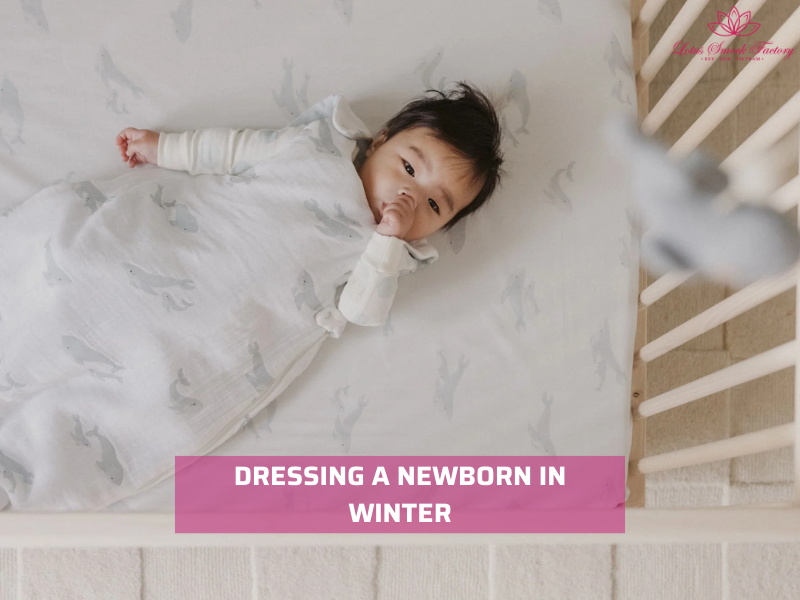
2. Winter Fabric & Layering Basics for Newborn Comfort
Parents should start winter dressing with fabric and layering for their newborn. The right combination keeps your newborn warm without causing discomfort or overheating. Below are things that you need to know when dressing in winter.
2.1. Best Fabrics for Winter Warmth
Choosing fabrics is the first step in winter dressing. Each material has strengths and limits, so balance is key.
- Cotton: Gentle on newborn skin and breathable. Works well as a base layer, but not warm enough alone in cold weather.
- Merino wool: Soft, natural, and regulates temperature well. It keeps warmth without making babies sweaty. Ideal for a middle layer.
- Fleece: Lightweight and warm. Dries quickly and is good for outer layers or sleep sacks. Not as breathable as cotton or wool.
2.2. How to Layer for Maximum Comfort
Layering helps newborns adjust warmth as conditions change. Think of it as building blocks for steady comfort.
- Base layer: Directly against the skin. Choose cotton or cotton-blend bodysuits.
- Middle layer: Adds warmth. Merino wool or fleece suits this role.
- Outer layer: Shields from wind and cold. Use a pramsuit, bunting bag, or blanket when outside.
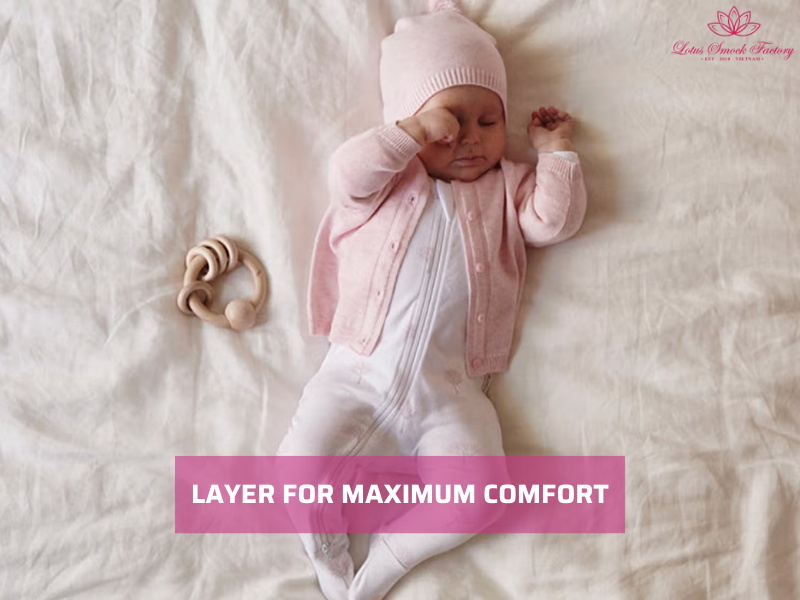
2.3. What to Avoid
Some clothing choices create more risks than comfort. Avoid these common fabric and layering mistakes.
- Bulky coats in car seats: They stop the harness from fitting tightly and reduce safety. Use a thin fleece jacket or cover baby with a blanket after buckling.
- Scratchy fabrics: Wool blends with rough texture can irritate skin. Always use soft, baby-safe versions.
- Synthetic fibers that trap sweat: Polyester mixes without breathability can make your newborn clammy. They keep heat in but do not let moisture out.
3. The Winter Newborn Dressing System (Temperature-Based Guide)
How you dress your newborn in winter depends on the temperature around them. Using a simple system helps you balance warmth with safety, indoors and outdoors.
3.1. Indoors (18–21°C / 64–70°F)
Keep your baby cozy without overheating. A common choice is:
- Long-sleeve cotton onesie as the base layer.
- Fleece sleep sack for extra warmth.
This combination works well for most heated homes. You should always check your baby’s neck or chest to see if they feel comfortable.
3.2. Outdoors (Mild Cold)
When the weather is cool but not freezing, layering is still needed. Try:
- Cotton base layer against the skin.
- Knit sweater as a middle layer.
- Footed pramsuit for warmth outside.
- This setup protects against wind while staying breathable.
3.3. Outdoors (Freezing Conditions)
In freezing weather, your newborn needs more protection. Therefore, a safe setup below can keep warmth good, including:
- Merino wool base layer for warmth and moisture control.
- Fleece mid-layer to trap heat.
- Insulated pramsuit for outdoor shielding.
- Hat, mittens, and booties to cover extremities.
- Always remove extra layers once you go back indoors.
3.4. Night Sleep in Winter
Nighttime dressing needs extra care, as overheating during sleep is risky. A TOG-rated sleep sack is the safest way to add warmth.
- COOL (16–20°C or 60.8-68°F): TOG 2.5 sleep sack.
- COLD (<16°C or <60°F): TOG 3.5 sleep sack.
Swaddling in cold weather is fine if you use breathable fabrics and keep the head uncovered.
Note: You can also use the TOG ratings and summer temperatures to know how to dress a newborn in summer.
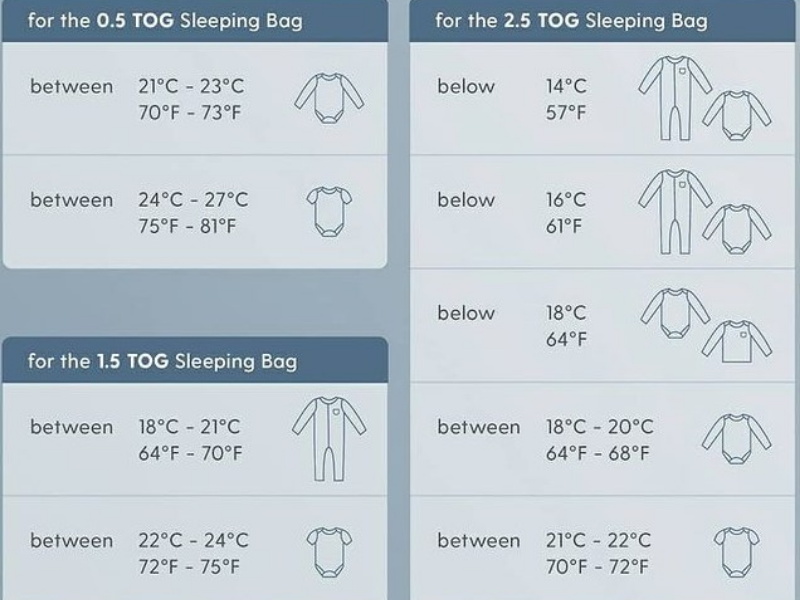
Experience Tip: Parents in colder US states often keep bedrooms cooler but use higher-TOG sacks. In the UK, many prefer to add a thin, breathable blanket over the sleep sack if the room temperature is steady and safe.
4. Safe Sleep Guidelines for Winter
Newborns need extra care during winter sleep. The goal is to keep them warm without overheating. Both the American Academy of Pediatrics (AAP) and the NHS give clear advice that parents can follow.
- Room temperature: Keep the nursery between 18–21°C (64–70°F). This range helps babies sleep safely without getting too hot or too cold.
- No loose blankets: Avoid putting blankets, quilts, or pillows in the crib. Instead, use a sleep sack or swaddle with the right TOG rating for the room temperature.
- Head uncovered indoors: Hats and hoods should not be used for sleep inside the house. Babies release heat through their heads, and covering it can cause overheating.
Note: Safe winter sleep is about balance. You should use breathable fabrics, check your baby’s chest or neck for warmth, and adjust layers as needed.
5. Step-by-Step: How to Choose the Right Winter Outfit for Your Newborn
Dressing a newborn in winter can feel confusing, but a simple step-by-step approach makes it easier. Follow these four steps to balance warmth and safety.
Step 1: Check the forecast and indoor heating level
- Look at both outdoor and indoor conditions before dressing your baby.
- Cold weather outside may not matter if you spend most of the day indoors with heating.
Note: Check the room temperature and plan layers accordingly.
Step 2: Pick a breathable base layer
- Choose a soft cotton or merino onesie as the first layer.
- A good base helps regulate temperature and keeps skin comfortable.
- Avoid polyester or fabrics that trap sweat.
Step 3: Add layers depending on activity/location
- Indoors: add a light sleep sack or sweater if the room is cool.
- Outdoors: use a mid-layer (like fleece) plus a pramsuit, hat, and mittens.
- Freezing conditions: add more insulation but keep fabrics breathable.
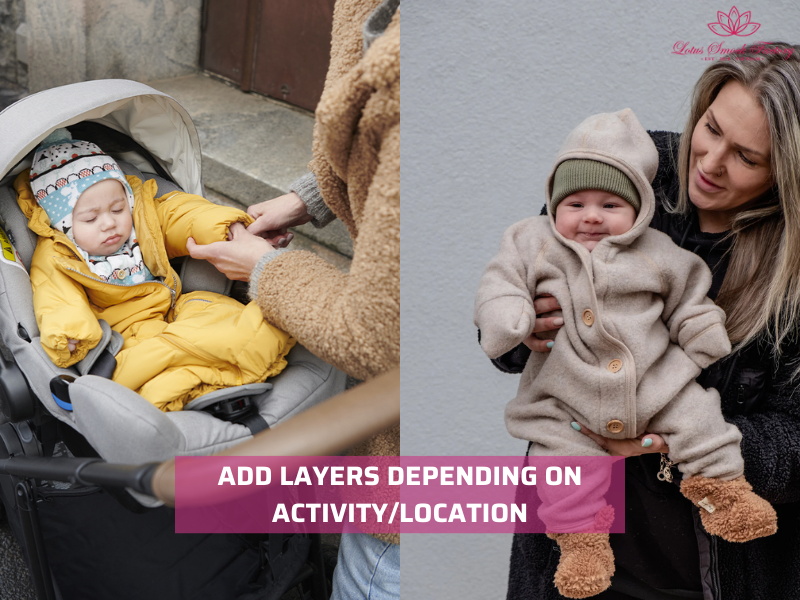
Step 4: Adjust on the go and check baby’s comfort often
- Feel your baby’s chest or back of the neck to check warmth.
- Remove layers when you enter a heated space to prevent overheating.
- Add back layers before going outdoors again.
By checking the environment, building layers, and adjusting as needed, you keep your newborn safe and comfortable through the winter.
6. Recognising Signs of Overheating and Chilling
Newborns cannot tell you when they are too hot or too cold, so you need to watch for physical signs. Quick checks help you adjust their clothing and keep them safe.
Signs your baby is too cold
- Hands and feet feel cold even when covered.
- Skin looks pale, blotchy, or bluish.
- Baby may seem less active or more fussy than usual.
=> What to do: You should add a layer, hold your baby close for warmth, and check the room temperature. Avoid placing them near direct heat sources.
Signs your baby is too hot
- Back of the neck feels sweaty or damp.
- Skin looks flushed or feels very warm.
- Baby may appear restless, cry more, or have a faster heartbeat.
=> What to do: You remove a layer, move to a cooler space, and offer fluids if age-appropriate (for newborns under six months, breast milk or formula only).
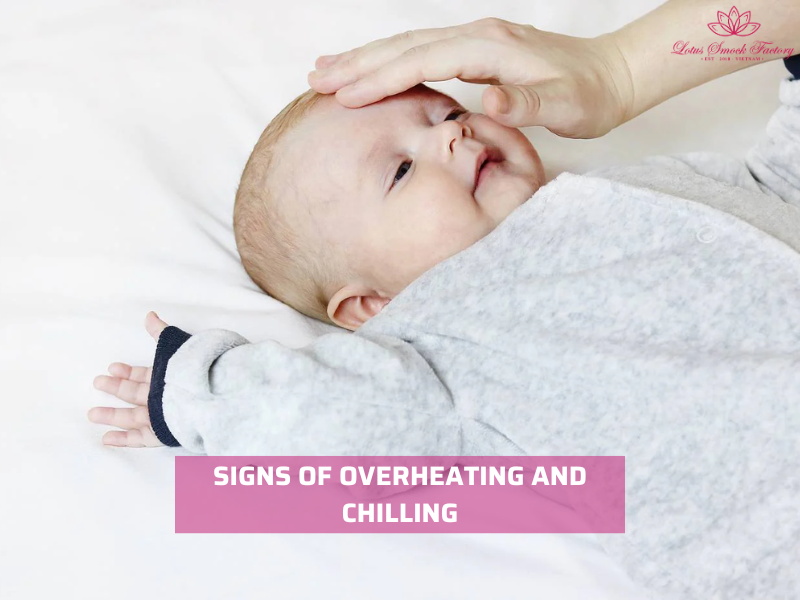
By checking your newborn’s skin and comfort often, you can respond quickly to overheating or chilling before it becomes a risk.
7. Common Mistakes Parents Make in Winter Dressing
Dressing a newborn in winter can feel tricky. Parents often add too much clothing out of fear of the cold. However, some habits can put your baby at risk of overheating or discomfort.
Over-bundling indoors
Many parents believe babies always need extra layers inside. In reality, most heated homes stay between 18–21°C, which is safe with just one more layer than an adult wears. Too many blankets or clothes indoors can quickly cause overheating.
Using non-breathable fabrics
Heavy synthetic fabrics like polyester or acrylic can trap sweat and make your baby damp and chilled. Breathable natural fabrics such as cotton or merino wool regulate temperature better and keep skin comfortable.
Forgetting to adjust layers after coming indoors
It’s easy to forget to remove coats, hats, or pramsuits once you step inside. Keeping these layers on in a warm room can cause your newborn to sweat and overheat. Always remove outdoor layers as soon as you come back indoors.
FAQs
Q1: Can a newborn sleep in a hat in winter?
No. A newborn should not sleep in a hat indoors, even in winter. Covering the head can make your baby overheat and increases the risk of unsafe sleep. Instead, keep the room at 18–21°C and dress your baby in a sleep sack with the right TOG rating.
Q2: How many layers for a newborn at night in 18°C?
At 18°C, your newborn usually needs a long-sleeve cotton onesie and a 2.5 TOG sleep sack. This setup gives enough warmth without overheating. The “one more layer than you” rule also helps: if you sleep in one layer, your baby likely needs two.
Q3: Is fleece safe for newborn sleep?
Fleece is warm but not always breathable. For daytime naps or outdoor use, it can be fine as a mid-layer. For night sleep, choose cotton or merino wool sleepwear instead. If you use fleece, keep the room cooler and check your baby’s neck and chest for signs of overheating.
Final Words
Now you know how to dress a newborn in winter with the right layers, fabrics, and safe sleep practices. Always check your baby’s neck or chest to see if they feel too hot or too cold. Moreover, adjust clothing as you move between indoors and outdoors. With these simple tips, you can protect your baby from both cold and overheating.
Start using these steps today and enjoy peace of mind while caring for your newborn in winter.
Start applying these tips today to protect your baby from the cold while avoiding overheating. And if you’re looking for more trusted guides on baby clothing, comfort, and safety, don’t forget to explore our latest products here at Lotus Smock Factory. We’re here to support you in giving your baby the safest and coziest start to life.
